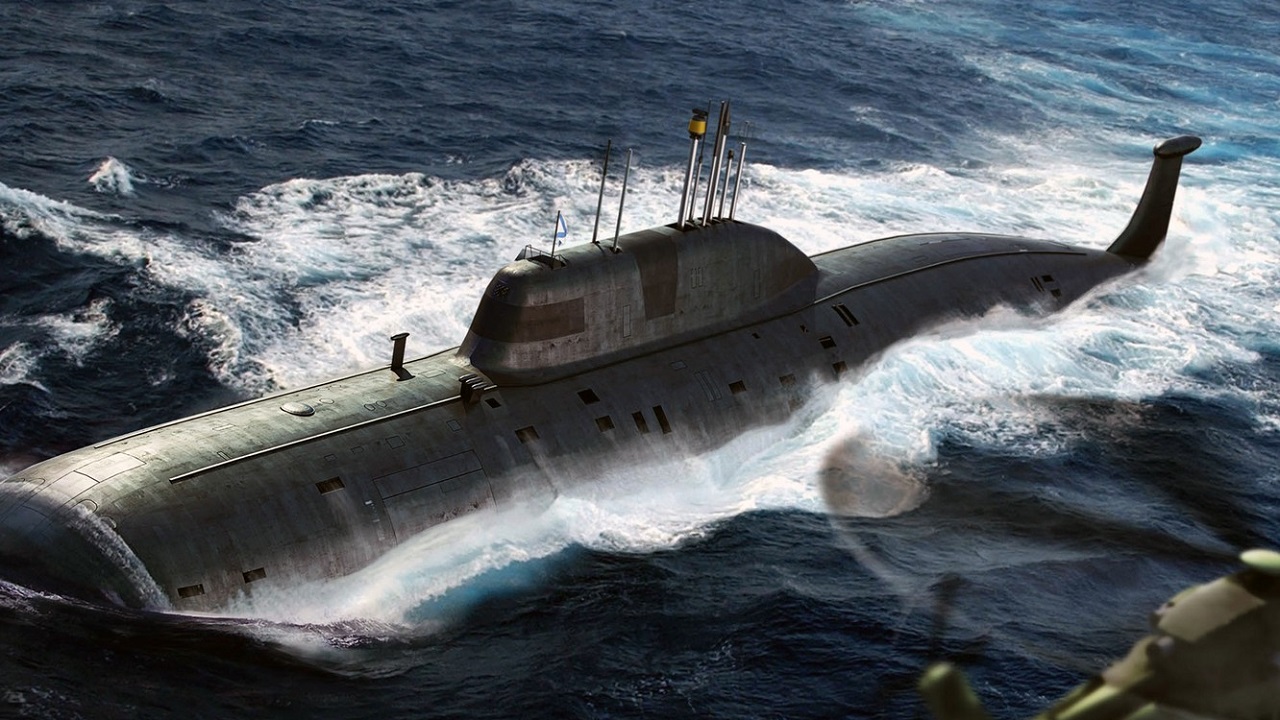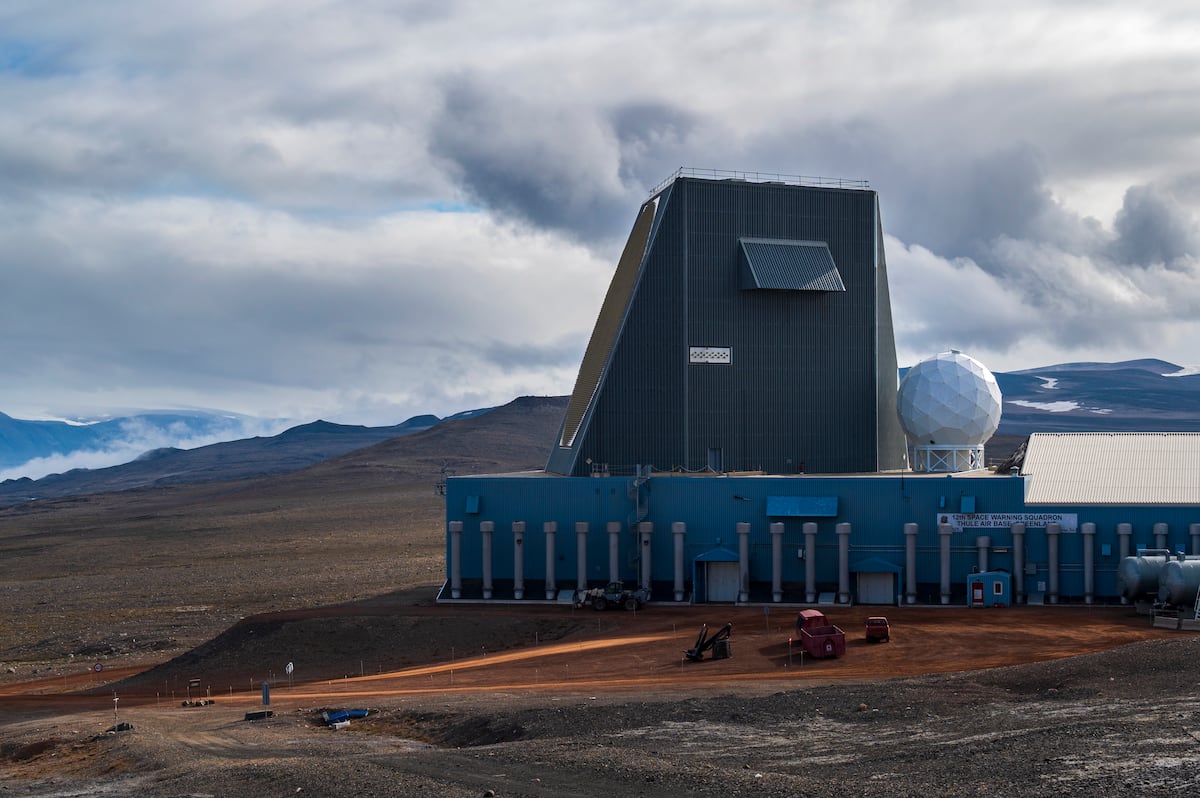The Akula-Class Submarine: Everything You Always Wanted to Know
In the clandestine, high-stakes undersea chess match of the Cold War, the sudden appearance of a new Soviet submarine in the mid-1980s sent a shockwave through Western naval intelligence.
The Project 971 Shchuka-B nuclear-powered attack submarine (SSN) was not merely an incremental improvement; it was a technological and strategic disruption of the highest order. Its arrival on the scene, years ahead of Western projections, signaled the abrupt end of an era of comfortable acoustic superiority for the U.S. Navy and its NATO allies.
K-322 Cachalot, Akula class submarine underway. A port quarter aerial view of the Russian Northern Fleet AKULA class nuclear-powered attack submarine underway on the surface.
The West had not anticipated that the Soviet Union could produce a vessel with such a low acoustic signature for at least another decade, and this miscalculation forced a frantic re-evaluation of anti-submarine warfare (ASW) doctrine and technology.
The Akula, as it would come to be known, was the shark in the water that no one saw coming.
The class is subject to a persistent and often confusing naming convention. The official Soviet design designation for the program was Project 971 Shchuka-B (meaning “Pike-B”). However, the lead vessel of this new class was christened K-284 Akula (“Shark”).
In accordance with its standard practice of using the lead ship’s name for a new class, NATO assigned the reporting name “Akula.” This created a point of ambiguity, as the Soviet Navy had already designated its massive Project 941 ballistic missile submarines as the Akula class, which NATO in turn had designated the Typhoon class.
For the sake of clarity and alignment with common Western convention, this report will refer to the Project 971 Shchuka-B as the Akula class.
The Akula was a paradigm shift in Soviet submarine design, born from a confluence of industrial necessity, strategic desperation, and illicitly acquired technology. For the first time, Soviet engineers prioritized stealth over the traditional performance metrics of raw speed and extreme diving depth.
The result was a formidable hunter-killer that not only reshaped the final years of the Cold War but continues to serve as a potent and lethal strategic asset for the Russian Navy and its international partners well into the 21st century.
Its story is one of remarkable engineering, espionage, and enduring influence on the silent war beneath the waves.
A New Philosophy in Undersea Warfare: Design and Engineering
The Akula-class was not simply an evolution of previous Soviet designs; it was the product of a fundamental revolution in their entire approach to submarine warfare. Confronted by the quiet proficiency of a new generation of American submarines and hobbled by critical industrial limitations, designers at the Malakhit Central Design Bureau in St. Petersburg were forced to innovate. They conceived a vessel that masterfully balanced the competing demands of survivability, stealth, and lethality, creating one of the most successful submarine designs in modern history.
A Pragmatic Response to Strategic and Industrial Realities
The impetus for the Akula-class program, which began in the early 1980s, was the urgent need to counter the formidable capabilities of the U.S. Navy’s Los Angeles-class SSNs.
The Soviet Navy required a true third-generation hunter-killer submarine that could effectively stalk these quiet American boats, protect its own vital ballistic missile submarine (SSBN) bastions in the Arctic, and threaten NATO surface fleets.
The direct technological predecessor to the Akula was the highly advanced Project 945 Sierra class. The two Sierra-class boats were revolutionary, featuring lightweight and incredibly strong titanium hulls that allowed for exceptional speed and diving depth.
However, their construction exposed a critical bottleneck in the Soviet military-industrial complex: the specialized infrastructure required to machine and weld titanium hulls on a mass scale was simply inadequate. This made the Sierra class prohibitively expensive and agonizingly slow to produce, rendering it unviable as the future backbone of the Soviet SSN fleet.
This industrial reality forced a strategic pivot. Rather than abandoning the high-performance goals set for the Sierra, Soviet designers adapted with remarkable pragmatism. The decision was made to construct the new Project 971 boats with a more conventional, but still very high-strength, low-magnetic steel hull.
This allowed for much faster and more cost-effective production at multiple shipyards. Through clever design and the integration of advanced quieting technologies, the resulting Akula class achieved a performance profile that was a very close approximation of the titanium-hulled Sierra, but at a fraction of the cost and with far greater production feasibility.
This shift illustrates a core tenet of late-Soviet design: the ability to adapt engineering solutions to overcome industrial constraints without compromising primary strategic objectives. The Akula is thus not just a successor to the older Victor III class, but a direct and more producible descendant of the hard-won lessons from the Sierra program’s industrial challenges.
The Double Hull and Propulsion System
A defining characteristic of the Akula, and indeed of most Soviet and Russian submarine designs, is its double-hull construction.
This architecture features a robust inner pressure hull, which contains the crew, reactor, and all critical systems, and a separate, hydrodynamically shaped outer “light” hull.
The significant standoff distance between these two hulls provides an enormous volume for reserve buoyancy, estimated to be as much as three times that of a comparable Western single-hull submarine.
This design feature dramatically increases survivability, allowing the submarine to absorb significant damage, including from a torpedo impact, and remain afloat even with one or more of its seven main compartments completely flooded.
This design philosophy reflects a historical Soviet emphasis on combat survivability and the ability to “fight hurt,” a stark contrast to the Western design approach that prioritizes crew comfort, internal volume, and acoustic performance over raw damage resistance.
The heart of the Akula is its powerful and reliable propulsion system. Power is provided by a single OK-650B pressurized water reactor, a mature design with a thermal output of 190 megawatts that was also used in the Sierra, Oscar, and Typhoon classes.
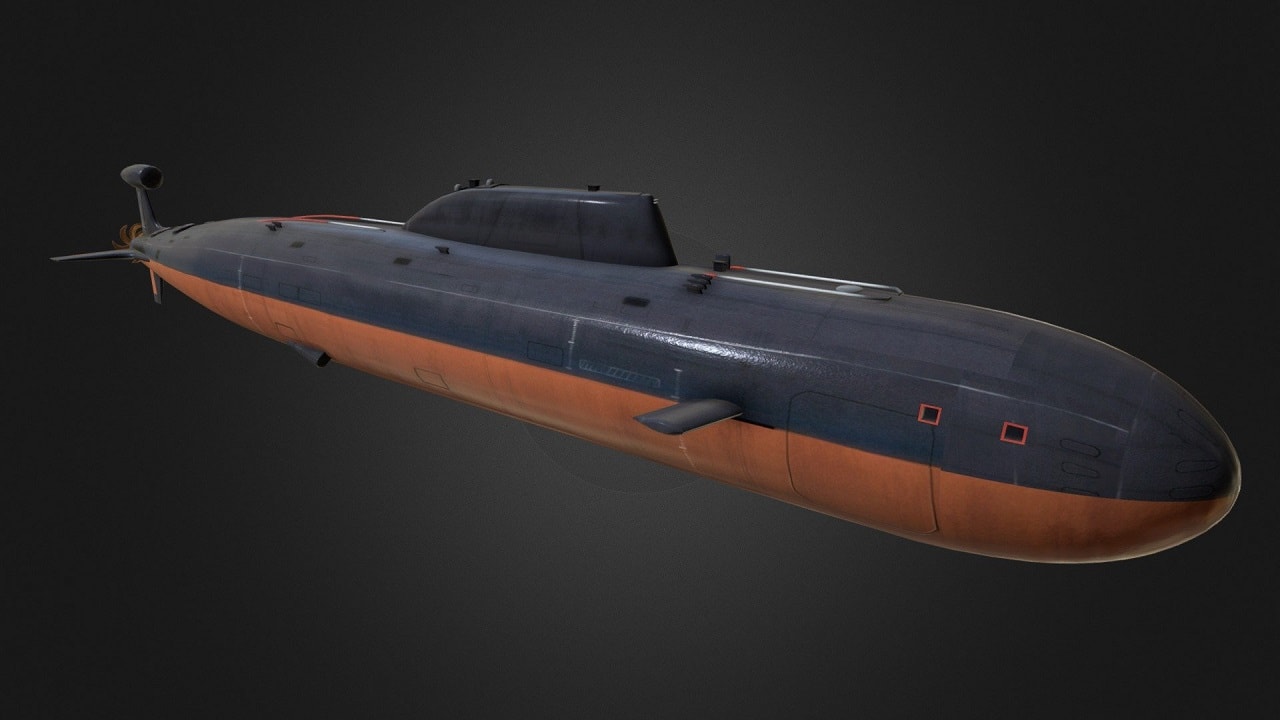
Russian Sierra-class nuclear-powered attack submarine. Artist rendering.
This reactor powers an OK-7 steam turbine that delivers approximately 43,000 to 50,000 shaft horsepower to a single, large, seven-bladed, high-skew propeller. For low-speed, ultra-quiet maneuvering, the Akula is also equipped with two retractable electric propulsors, or “thrusters,” which allow it to “creep” without using its main propulsion shaft, further reducing its acoustic signature.
This potent combination of power and advanced hydrodynamic design gives the Akula-class impressive performance, including a maximum submerged speed estimated between 33 and 35 knots and a maximum operating depth of 600 meters—significantly deeper than the 450-meter test depth of the improved Los Angeles-class it was designed to hunt.
The Quieting Revolution: A Systems Approach to Stealth
The most significant and strategically impactful achievement of the Akula-class was its dramatic reduction in acoustic signature. While previous generations of Soviet submarines were notoriously loud—often prioritizing speed and depth over stealth—the Akula represented a comprehensive, systems-level effort to achieve acoustic parity with the West.
This strategic shift was driven in large part by damning intelligence, including revelations from the John Walker spy ring which confirmed to the Soviets just how effective the U.S. Navy’s Sound Surveillance System (SOSUS) was at tracking their noisy boats across entire ocean basins.
The need to evade this vast underwater listening network became a paramount design driver.
The Akula’s revolutionary quietness was not the result of a single innovation but a convergence of multiple technologies, some indigenous and some illicitly acquired.
-The Toshiba-Kongsberg Connection: A critical, and highly controversial, element in the Akula’s development was the illegal sale of advanced Western technology to the Soviet Union. In what became known as the Toshiba-Kongsberg scandal, a subsidiary of Japan’s Toshiba Corporation and Norway’s state-owned Kongsberg Vaapenfabrikk conspired to sell the Soviets sophisticated multi-axis, computer-numerically controlled (CNC) milling machines.
These advanced machine tools gave Soviet shipyards the ability to manufacture large, complex, high-skew propellers with a degree of precision they previously could not achieve. This was a crucial breakthrough, as it allowed for the creation of propeller blades that sliced through the water with far less cavitation—the noise created by the formation and collapse of tiny bubbles on the spinning blades, which is a primary source of submarine noise at speed.
This illegal transfer of technology is widely credited with allowing the Soviets to make a sudden, multi-year leap in propeller-quieting technology.
-A Systems Approach to Stealth: This illegally acquired technology was integrated into a much wider, indigenous Soviet quieting program that treated stealth as a holistic design challenge. Key elements of this systems-based approach included:
-Machinery Rafting: To isolate noise from the powerful propulsion machinery, the entire power train and other noisy auxiliary systems were mounted on a massive internal “raft.” This raft was then isolated from the pressure hull by a two-stage system of pneumatic shock absorbers and rubber dampeners, preventing mechanical vibrations from being transmitted through the hull and into the surrounding water. This complex technique was first introduced on the preceding Victor III class and was perfected on the Akula.
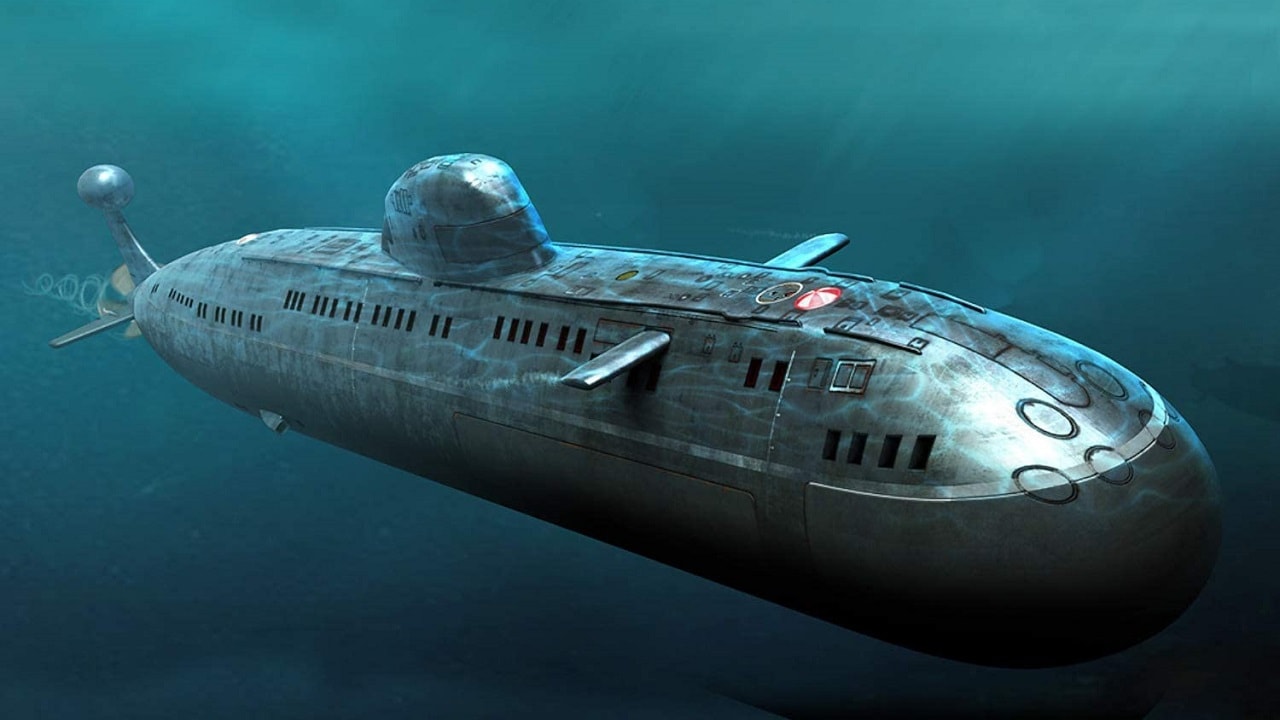
Victor III-class Submarine.
-Anechoic Tiles: The Akula’s outer hull is covered in thick, 100-mm rubber tiles. These tiles serve a dual purpose: they absorb the sound waves from an enemy’s active sonar, reducing the strength of the return echo, and they also dampen the high-frequency noises radiating from the submarine’s own internal machinery.
-Active Noise Cancellation: Some reports suggest that later Akula variants were fitted with active noise cancellation systems. These systems use an array of sensors to detect the specific frequencies of machinery noise and then produce an opposite, “out-of-phase” sound wave to actively cancel it out, further reducing the submarine’s acoustic signature.
-Hydrodynamic Design: The hull form was carefully shaped to ensure smooth, non-turbulent water flow. A key and unique feature is the use of retractable covers for the limber holes (the free-flooding ports in the outer hull), which can be closed at speed to reduce the significant noise generated by water flowing through them. The distinctive “teardrop” pod on top of the aft vertical stabilizer, which houses the deployable towed sonar array, is also hydrodynamically shaped to minimize turbulence and flow noise.
The convergence of these elements—strategic necessity driven by espionage, a dedicated indigenous engineering effort, and a final critical boost from illegally transferred Western technology—is what allowed the Akula to achieve its revolutionary quietness. This leap in acoustic stealth enabled the Akula to challenge the West’s undersea dominance for the first time, forcing a complete overhaul of NATO ASW tactics and technology.
The Akula Family: A Lineage of Lethality
The Project 971 program was not a static design but rather an evolutionary family of submarines, with at least four distinct sub-classes or “flights” produced at two different shipyards (Komsomolsk-on-Amur and Severodvinsk) between 1984 and 2009.
While Western intelligence assigned different designations to these variants (Akula I, Improved Akula, Akula II, Akula III), the Russian Navy officially refers to all of them as Project 971 Shchuka-B.
Authoritative sources often disagree on the precise designations, hull counts, and specific upgrades for each boat, reflecting the secrecy and incremental nature of the program.
The following table provides a consensus overview of the major variants and their key distinctions.
|
NATO Designation |
Soviet Project No. |
Key Distinctions & Enhancements |
Notable Hulls |
Status (as of early 2020s) |
|
Akula I |
Project 971 |
Baseline model, representing a quantum leap in stealth over the Victor-III class. Equipped with MGK-500/540 sonar. Eight internal torpedo tubes. |
K-284 Akula, K-480 Ak Bars |
Largely retired, in long-term reserve, or dismantled. |
|
Improved Akula I |
Project 971I / 971U |
Quieter than the baseline Akula I. Key upgrade was the addition of six external 533mm tubes, primarily for launching acoustic decoys. Most fitted with the SOKS non-acoustic sensor system. |
K-154 Tigr, K-152 Nerpa |
Forms the core of the active Russian SSN fleet, with several undergoing or having completed extensive modernization. |
|
Akula II |
Project 971A |
Features a noticeable 3- to 4-meter hull extension (“plug”) inserted aft of the sail to house more advanced quieting systems and machinery rafting. Widely rated as being quieter than the U.S. Improved Los Angeles-class. |
K-157 Vepr |
Single unit active in the Russian Navy; considered one of its most capable SSNs. |
|
Akula III |
Project 971M |
The ultimate development of the class, incorporating all previous quieting measures plus further refinements. Claimed by Russia to be comparable in stealth to the U.S. Seawolf-class. |
K-335 Gepard |
Single unit active in the Russian Navy; often described as the quietest and most advanced boat in the entire Akula family. |
The clear evolutionary path across these variants demonstrates a relentless, single-minded focus on improving acoustic performance with each successive hull.
The most visible evidence of this is the lengthened hull of the Akula II, K-157 Vepr. This “plug” was not added to increase weapon capacity or crew space; it was inserted specifically to create more internal volume for additional sound-dampening equipment and more effective machinery rafting, a physical manifestation of the paramount priority placed on stealth. The final boat, the Akula III K-335 Gepard, represents the pinnacle of this design philosophy, incorporating all previous lessons to become one of the quietest and most capable submarines in the entire Russian fleet.
The Teeth of the Predator: Armament and Sensor Systems
The Akula class was designed from the keel up as a hunter-killer, and its formidable capabilities were reflected in a powerful and versatile suite of weapons and sensors.
This combination of a stealthy platform and a lethal, multi-mission payload made it a credible threat to both heavily defended surface fleets and the quietest of enemy submarines.
A Versatile and Lethal Arsenal
The primary armament of the Akula class is delivered through a potent array of torpedo tubes located in the bow. All variants are equipped with four 650mm tubes and four 533mm tubes, a mixed-caliber arrangement that provides significant tactical flexibility.
The large 650mm tubes are designed to fire heavyweight, long-range anti-ship torpedoes like the Type 65-76, a wake-homing weapon capable of crippling or sinking large surface combatants such as aircraft carriers from a safe distance.
Alternatively, these large tubes can be fitted with liners to launch standard 533mm weapons, increasing the total number of smaller torpedoes that can be brought to bear against submarine targets.
The torpedo tubes are also used to launch a variety of powerful missiles, giving the Akula a true multi-mission capability. The weapon loadout can include up to 40 weapons in total, comprising a mix of torpedoes and missiles tailored to the specific mission.10 Key missile systems include:
–Anti-Submarine Missiles: The RPK-7 Veter (NATO: SS-N-16 Stallion), launched from the 650mm tubes, and the RPK-6 Vodopad (SS-N-15 Starfish), from the 533mm tubes, are rocket-propelled torpedoes. These weapons allow the Akula to engage enemy submarines at standoff ranges of up to 100 km, far beyond the range of an adversary’s torpedoes.
–Land-Attack Cruise Missiles: The ability to launch the S-10 Granat (NATO: SS-N-21 Sampson) land-attack cruise missile from its 533mm tubes gave the Akula a strategic strike capability comparable to U.S. submarines armed with the Tomahawk missile. The Granat has a range of up to 3,000 km and was designed to carry a 200-kiloton nuclear warhead, making the Akula a strategic threat even when operating in a conventional hunter-killer role. In recent years, modernized Akulas are being retrofitted to carry the newer, conventionally armed Kalibr cruise missile, significantly enhancing their tactical strike role in modern conflicts.
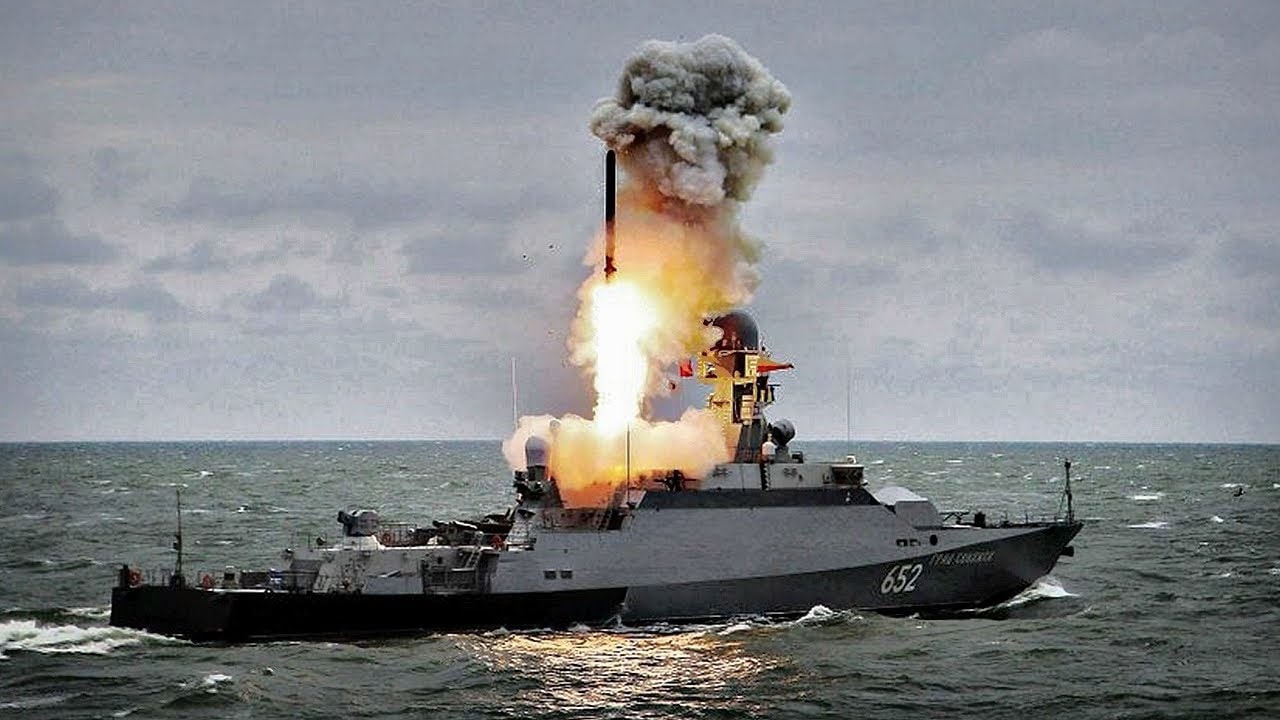
Kalibr cruise missile. Image Credit: Creative Commons.
Beginning with the Improved Akula I variants, an additional six external, single-shot 533mm tubes were mounted in the upper bow. These tubes cannot be reloaded at sea and are used primarily to deploy acoustic decoys, such as the MG-74 Korund noise simulator, to confuse and seduce incoming enemy torpedoes, thereby increasing the submarine’s survivability.
The Hunter’s Senses: A Paradox of Stealth
The Akula’s primary sensor is the MGK-540 Skat-3 (NATO: Shark Gill) integrated sonar system. This suite includes a large, cylindrical passive and active sonar array housed in the bow, below the torpedo tubes.10 This main array is supplemented by passive flank arrays mounted on the sides of the hull and a very-low-frequency towed passive sonar array that deploys from the distinctive pod atop the vertical rudder.
This combination of sensors allows the submarine to listen for enemy vessels across a wide range of frequencies and from multiple bearings, creating a comprehensive acoustic picture of the surrounding battlespace.
Despite the platform’s revolutionary quietness, however, Russian sources have suggested that the Akula’s sonar suite and its associated processing software were technologically inferior to their Western counterparts. The MGK-540 was said to possess lower sensitivity and the ability to track only two targets simultaneously, compared to the multiple-target tracking capability of the U.S. Navy’s AN/BQQ-5 system on the Los Angeles-class.

Los Angeles-Class Submarine. Image Credit: Creative Commons.
This created a significant tactical paradox: the Akula was an exceptionally quiet hunter that was itself somewhat “hard of hearing.” It could approach an adversary undetected, but might be at a disadvantage in a long-range detection duel against a submarine with superior sonar.
This technological gap likely explains the Soviet emphasis on fitting the Akula with alternative, non-acoustic detection systems. Most boats are equipped with the SOKS system, a suite of highly sensitive hydrodynamic sensors designed to detect the subtle disturbances and changes in water density—the wake—left by another submarine’s passage.
This provided a means of tracking a target that did not rely on acoustics, partially compensating for any sonar deficiencies and reflecting a uniquely Soviet approach to the complex challenges of undersea warfare.
Akula-Class: Operational Legacy, Incidents, and Future Horizons
The Akula-class has had a long and impactful service history, from its game-changing entry at the height of the Cold War to its ongoing role as a cornerstone of the modern Russian Navy. Its operational legacy is marked by audacious strategic patrols that shocked the West, a tragic peacetime accident that highlighted the challenges of the post-Soviet era, and a continuing role as a valuable and sought-after asset for both Russia and its strategic partners.
The Silent Service in Action: Ending an Era of Supremacy
The deployment of the first Akula-class submarines in the late 1980s had an immediate and profound effect on Western naval strategy. Declassified reports later confirmed that Akula-class submarines conducted unprecedented patrols deep into the Atlantic, operating undetected for extended periods off the U.S. East Coast, in close proximity to critical naval bases such as the SSBN homeports of Kings Bay, Georgia, and Bangor, Washington.
The ability of these submarines to approach the continental United States without being tracked by the vast SOSUS network was a clear and alarming demonstration that the West’s decades-long acoustic advantage had been decisively erased. This new, credible threat from a quiet Soviet SSN forced a major strategic rethink within the U.S. Navy and was a primary driver behind the acceleration of the development of the next generation of American attack submarines, the ultra-quiet and heavily armed
Seawolf class, which was designed with the specific mission of hunting and killing the Akula.
The Nerpa Tragedy: A Case Study in Post-Soviet Risk
The otherwise impressive operational history of the Akula-class is marred by a significant tragedy. On November 8, 2008, during sea trials in the Sea of Japan, the K-152 Nerpa (an Improved Akula I variant) suffered a catastrophic accident. The vessel’s fire suppression system was accidentally activated, flooding two forward compartments with Freon gas. The incident resulted in the deaths of 20 men and injured 41 others.
The high casualty count was exacerbated by the fact that the submarine was carrying a large contingent of 127 civilian technicians and shipyard workers alongside its 81-man military crew; many of these civilians were completely unfamiliar with the ship’s emergency procedures and the proper use of its emergency breathing apparatus.
The investigation into the disaster revealed a complex and contested chain of events. The Russian Navy’s initial report blamed a single enlisted sailor for having “improperly” or “playfully” activated the system from a control console, suggesting a case of gross human error.
However, the accused sailor was later acquitted in two separate trials. Defense testimony and further evidence pointed to a more complex set of systemic failures. The fire suppression system was a new, fully automatic type that had reportedly malfunctioned during previous tests, and some of its operating instructions were written in English, as the submarine was being prepared for a high-stakes lease to the Indian Navy.
Furthermore, survivors reported that the audible alarm that should have preceded the gas release failed to sound and that many of the emergency breathing apparatuses either malfunctioned or were quickly depleted.
The Nerpa accident serves as a stark illustration of the systemic risks facing the post-Soviet military. The combination of complex legacy technology, a platform whose construction was stalled for years by post-Soviet funding shortfalls, degraded training standards for non-military personnel, and the immense pressure of fulfilling a major international contract created a high-risk environment. The tragedy was likely not the result of a single point of failure but rather the culmination of systemic friction within a navy attempting to operate top-tier equipment without the robust industrial and training support structures of its Soviet predecessor.
The Akula’s Second Life and Enduring Legacy
Despite its age, the Akula class continues to play a vital strategic role, not just for Russia but also for its key international partners. A central component of this is the program to lease these highly capable submarines to the Indian Navy. The K-152 Nerpa, following repairs and a formal commissioning into the Russian Navy, was leased to India from 2012 to 2021, where it served as INS Chakra II.
This arrangement provided the Indian Navy with an invaluable platform for training its crews and developing the complex doctrines necessary for operating a nuclear submarine fleet, paving the way for its own indigenous SSN and SSBN programs.
This strategic partnership continues. In 2019, India signed a new $3 billion agreement to lease another, more modern Akula-class submarine, which will become INS Chakra III upon its expected delivery around 2028.41 This long-term leasing program serves multiple purposes: it provides a steady and significant revenue stream for Russia’s defense industry, strengthens geopolitical ties with a key partner in the Indo-Pacific, and gives the Indian Navy a crucial capability bridge as it works to build its own fleet.
The Akulas remaining in the Russian fleet form the backbone of its nuclear attack submarine force. Several of these boats are undergoing or have completed extensive overhauls and modernizations to extend their service lives and enhance their capabilities. A key upgrade is the integration of the modern, long-range Kalibr land-attack cruise missile, which significantly improves their conventional strike power and relevance in modern conflicts.
These modernized Akulas will continue to serve as Russia’s primary hunter-killers until they are gradually replaced by the new Project 885 Yasen-class submarines, a process expected to continue through the 2020s and beyond.
Conclusion: The Akula-Class Sails Into History
The Project 971 Shchuka-B Akula class stands as a landmark achievement in the history of submarine engineering and a pivotal player in the final act of the Cold War. It was a game-changing vessel that shattered Western assumptions about Soviet technological limits and forced a fundamental and costly recalculation of the undersea balance of power.
The Akula embodied a uniquely Russian design philosophy, blending a traditional emphasis on speed, depth, and raw survivability with a new, pragmatic, and ultimately successful quest for acoustic stealth. This was achieved through a combination of clever indigenous design, a willingness to adapt to harsh industrial realities, and the controversial acquisition of key Western technologies.
Despite its age and the operational challenges of the post-Soviet era, vividly illustrated by the Nerpa tragedy, the Akula’s potent design ensures its continued relevance. As a formidable hunter-killer in the Russian fleet, a valuable strategic export to key partners like India, and a crucial bridge to Russia’s future undersea fleet, the “Shark” continues to patrol the depths.
It remains a powerful and enduring legacy of the Cold War’s final, most sophisticated, and most silent technological battle.
About the Author: Harry J. Kazianis
Harry J. Kazianis (@Grecianformula) is a national security expert based in Orlando, Florida. Kazianis was Senior Director of National Security Affairs at the Center for the National Interest (CFTNI), a foreign policy think tank founded by Richard Nixon, based in Washington, DC. He also served as Executive Editor of its publishing arm, The National Interest. Harry has over a decade of experience in think tanks and national security publishing. His ideas have been published in the NY Times, Washington Post, Wall Street Journal, CNN, and many other outlets worldwide. He has held positions at CSIS, the Heritage Foundation, the University of Nottingham, and several other institutions related to national security research and studies.
